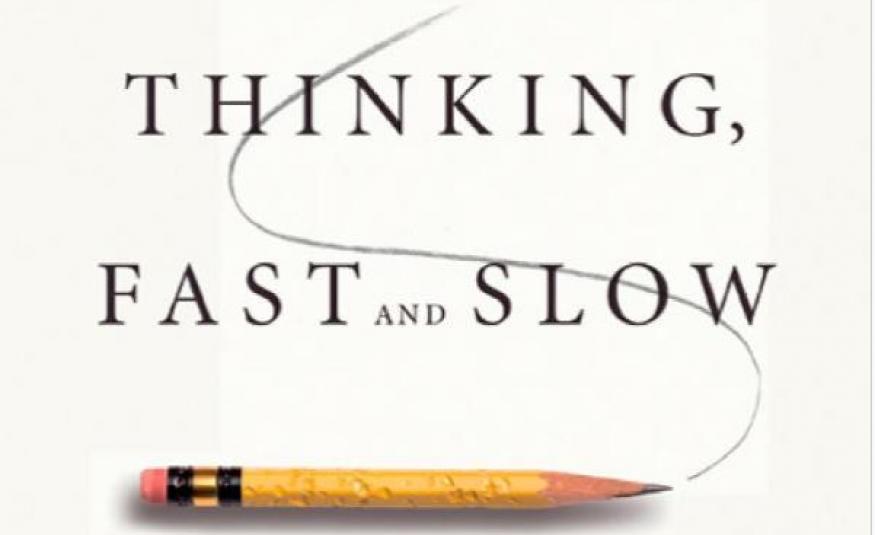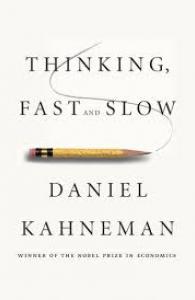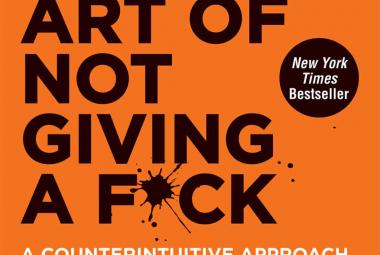This fantastic book, thinking, fast and slow, is full of psychological explanations of humans behaving irrationally. Because of the high information intensity of this book, it is impossible to make a summary of 1000 words. This article will therefore only include the few lessons I found most interesting, liker reasons why people play the lotto even though the ´know´ their shot at winning is statistically small, why people overestimate their own performance and why people deteriorate from their (new year’s) resolutions when they are busy.
THE AUTOMATIC AND THE RATIONAL SYSTEM
Kahneman describes two systems which determine the way people react in a certain situation
- System 1 can be described as the human automatic pilot. Intentions, impressions, feelings and inspiration trigger this system. It costs little effort to trigger this system and is therefore difficult to manage
- System 2 describes the human rational system. This system costs a lot of effort to trigger and is used to manage the automatic system 1. This system leads to self-control.
Both using the second system as well as switching tasks within the second system cost a lot of energy, except when people are in flow. Flow describes the state of effortless concentration which in such a deep level that sense of time, self and problems in that moment are completely forgotten.
When system 2 over processes, it loses its grip over system 1, which means we lose our self-control. This is the stressful moment where we suddenly forget our rational resolution and go straight for the junk-food we promised ourselves we wouldn’t eat. In this case, the first reaction or hinge is not necessarily the right one. Because our instinctive system 1 tells us to do something, it becomes very difficult for the exhausted system 2 to evaluate that decision, and therefore it doesn’t.
THE EXPERT´S TRUTH
Herbert Simon said that intuition is nothing else then recognition (system 1). Every situation includes stimulants and there stimulants help access certain information in one´s memory, which then leads to a answer on how to respond in that situation.
This means intuition can only be trusted when the person has a certain level of skills to use in any situation. Skills are learned from two basics conditions:
- The environment in which the person operates in has a certain level of predictability
- The person has had long term practice in practicing the skill in this relatively predictable environment
Only when both conditions are met, intuiting can be trusted.
ESTIMATING WITHOUT BIAS
People use their intuition to make estimations. We have now learned that intuition can only be trusted when people have gained experience in handling situations in which estimations need to be made. To make estimating a little more valid when the experience is not there, the statistical average should be used to rationally make the estimation. Kahneman describes four steps:
- Start at estimating the average value of a certain parameter, for instance 50%
- Use clues of the current situation to estimate the parameter to be higher or lower than the average. Let´s say we are in a situation where the value is expected to be higher than 50%.
- Now, estimate the correlation between the average and the current situation. How much different is the current situation? Let´s say it´s about 20% different than other situations.
- Use the correlation number to in- or decrease the average number to reach your estimated value, in this example 50% + (20% of the 50%) = 60%.
A different topic is the PROSPECT THEORY which Kahneman designed together with Amos. In this theory, human psychological reactions based on hope-to-gain and fear-to-lose are categorized in four quadrants. A few conclusions were:
- When the chance is small to win something big, people gain hope and as a result are willing to take a risk, like in lotteries.
- When the chance is big to win something big, people are afraid of getting disappointed and are therefore scared of the risk. This is the reason why people are settling in court, the winning party is afraid of disappointment
- When there is a big chance to lose big, people are willing to take a risk to prevent the loss from happening, like engaging in criminal activities.
- When there is a small chance of losing big, people are afraid of the risk of being that one person that it can happen to again. This is why people take so many expensive insurance policies.
Finally, Kahneman describes some PSYCHOLOGICAL EFFECTS which can mislead system 1.
- The Mere Exposure Effect describes the fact that we tend to judge a word or face more positively when we see it more often, even though it was so fast that we haven´t realized we saw it. System 1 in this case recognizes the word of face without a context.
- The Positive Test Theory, or conformation bias, which means judgment on a certain situation, will be based on the way the question about that situation is asked.
- The Halo-effect, the tendency to like or hate everything about a person, including characteristics you haven´t experienced yet. System 1 tends to remember the first impression. This can be tested by answering the following question:
how do you feel about the following two people after reading these descriptions?
Dirk = Intelligent, Active, Impulsive, critical, stubborn and Jealous
David = Jealous, stubborn, critical, impulsive, active and intelligent - The Reference-effect. People tend to judge a value when a reference value is mentioned even though it has nothing to do with the question. When asking for funds for charity, a reference value of $5 led to an average donation of $20, where a reference value of $400 to a donation of $143!
- The Availability bias describes the tendency to believe something to be true when examples can be drawn from memory. When you ask a couple to estimate their contribution to the household, the total percentage will almost always be higher than 100%.
However, the more difficult it gets to name examples, the less people believe something to be true. For instance, when people were asked to rank their own assertiveness, they ranked themselves more assertive when they were also asked to give three examples, compared to when they also needed to give twelve examples.
Kahneman gives the reader a great insight in how psychology works. The examples in this article are just a few of the many things described in his book: Thinking, fast and slow.
Continue to:
7 Habits of highly Effective People - S. Covey (summary)
REFERENCE:
Kahneman, D., 2011, Thinking Fast and Slow, New York: Farrar Straus and Giroux (order this book)
In the following video by FightMediocrity, thinking fast and slow is perfectly explained:















